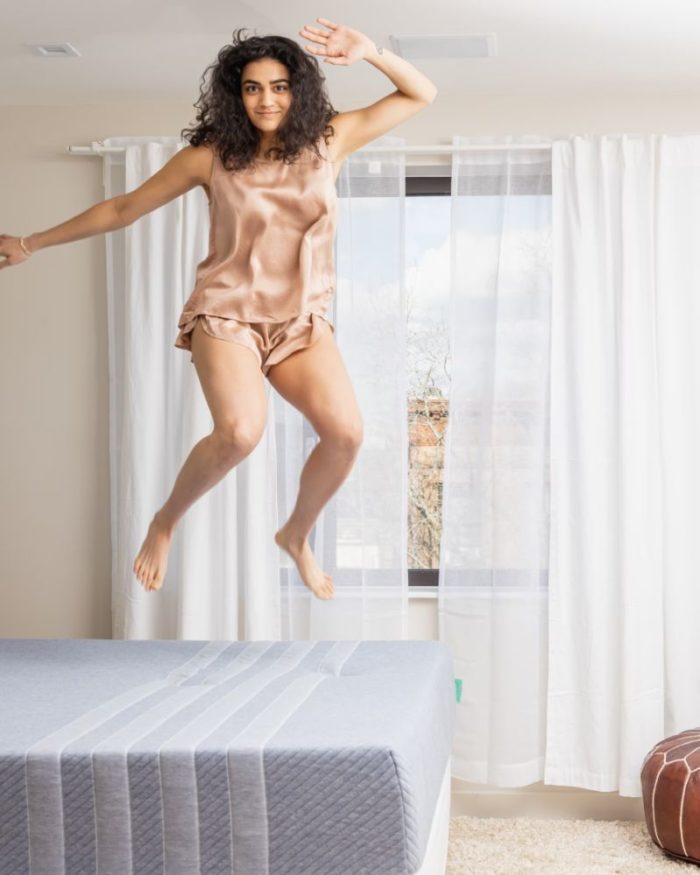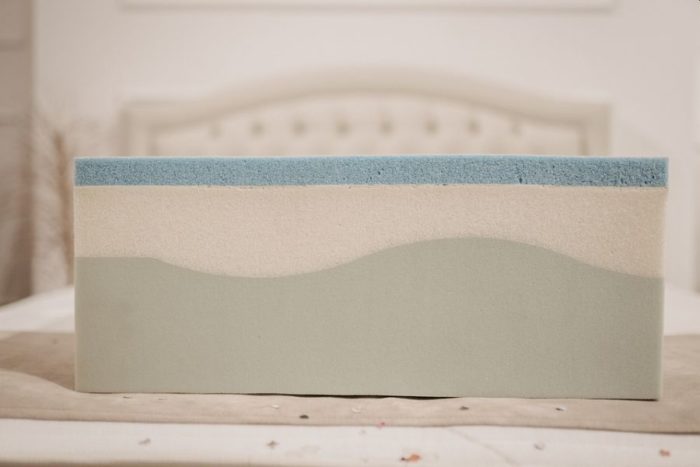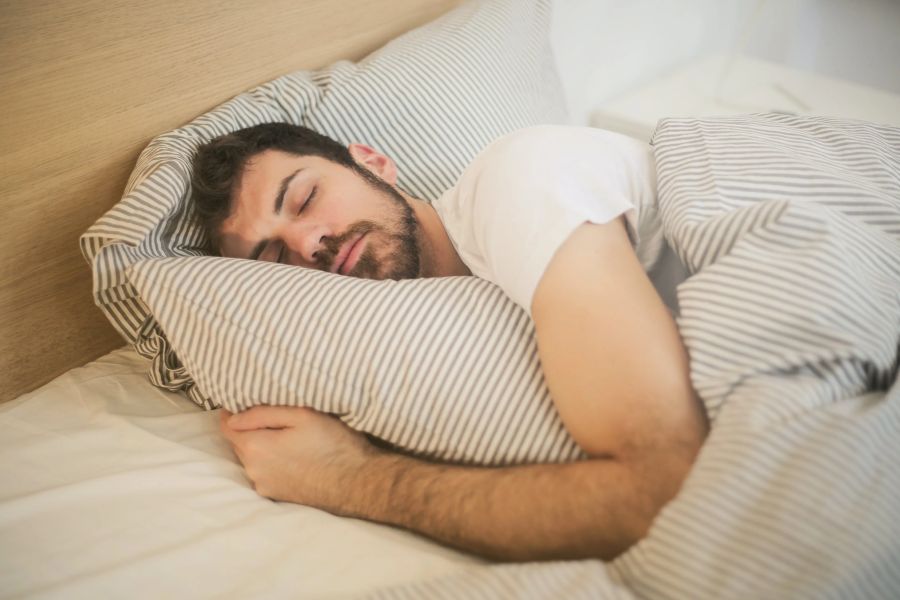Memory foam mattresses often get advertised as great picks for relief from back pain. But advertising can be tall claims and several customer reports go in a different direction. So, is memory foam good for your back?
Here’s an in-depth analysis to answer that for you!
The Root Of Back Pain And How Memory Foam Mattresses Matter
Ever wake up with a sore back? There could be a long list of reasons, ranging from your sleep position to the mattress and more. However, the root cause usually comes down to the alignment of the spine while sleeping.
Pressure Points And Spine Alignment With Memory Foam
An excellent and very useful property of memory foam is that it responds to heat and pressure. So, as a person is lying on a memory foam mattress, the foam responds to body heat and weight by molding itself to the body’s shape.
By conforming to the body, the foam distributes body weight evenly. Thanks to this, most sleepers love the feel of sleeping on memory foam mattresses.
On memory foam, pressure points like the shoulders and pelvic area sink in further into the foam as compared to other body parts. With the foam conforming to the body and cradling it, the body doesn’t feel the awkward effects of weight on pressure points.
Incidentally, this also allows for a better alignment of the spine. Once the body is in a comfortable position, the spine can stay straight and aligned. This is a big part of why memory foam mattresses are considered good for your back.
There is one very common negative for these properties of memory foam. Since it responds to body heat, the foam is very skilled at trapping it as well. Memory foam mattresses can feel uncomfortably hot for some people and may need some tinkering to cool down.
On the other hand, plenty of people never see this problem and some even prefer the mattress’s warm touch.
So, even with its excellent credentials, why do some people find that memory foam mattress causes back pain? Several factors could contribute to this problem. Let’s get a better understanding.
Uncomfortable Memory Foam Mattress? Here Are Some Points To Ponder
Your New Mattress Isn’t Broken In Yet
You’ve got a shiny, new memory foam mattress. It’s time to have a relaxing sleep and enjoy that feeling of weightlessness that people can’t shut up about.
Not so fast.
Memory foam mattresses (and all mattresses in general) can take time before they’re set and comfortable. If you got a bed in a box, give it a couple of days to expand to its full thickness. But that’s not the point here.
Mattresses will sometimes take their sweet time getting comfortable. They need to be broken in before they’re truly comfortable. There’s a double entendre somewhere here comparing wild stallions and memory foam mattresses, but I can’t quite figure it out.

Some mattresses can take as long as 30-60 days to break in. It is important to use the mattress during this time, even if you don’t sleep on it. When you have time, sit on it, walk on it, and maybe dance a bit too! If it’s not too uncomfortable, sleep on the memory foam mattress.
This is a big reason why most mattress companies offer sleep trials going to 100 days and more. If you have a new mattress, give it some time to settle.
The Body May Need Time To Adjust To A New Mattress
Bought a high-quality memory foam mattress and woke up with back pain? You could say the tempur-pedic is killing my back, but it’s better to get a deeper look.
Expensive as they are, Tempur-Pedic mattresses are usually worth it. Of course, sometimes we use tempur-pedic as a catch-all term for memory foam mattresses, not just those from the specific company. In the case of a random brand, it might not be so easy to reach exact conclusions. Still, it’s a good idea to be thoughtful before laying the blame on the mattress.
If you moved to a new, better mattress after using a crappy or old mattress, there are some chances of back pain. Generally, this is ascribed to the (good-quality) mattress helping the spine back into proper alignment. This pain is temporary and should go away in about a week.
If you feel this pain, it should be mild and manageable. If you keep waking up with terrible back pain, don’t brave it. Consider avoiding the offending mattress for a while and see a doctor for the pain.
There Is A Relationship Between Your Sleep Position, Weight, And Mattress Firmness
Everyone has their own sleeping style and sleep preferences. Your mattress should work with these preferences.
Mattresses don’t often take a one-size-fits-all approach. Consider a mattress that’s better suited to your sleep preferences and needs. This involves picking the right mattress firmness for your weight and preferred sleep position.
Sleep positions have three categories.
- Stomach Sleepers.
- Side Sleepers.
- Back Sleepers.
You could also add in combination sleepers or restless sleepers who keep moving through the night, but the above categories usually cover a large base.
The best mattress for side sleepers is usually a plush mattress. Stomach sleepers need a firm mattress, while back sleepers can get by with medium-firm mattresses.
There’s one factor that changes all these assumptions: Weight.
If a person weighs beyond the average weight range and is heavier than 250 pounds, they should buy firm mattresses. Side sleepers in this range can be comfortable with a medium-firm mattress (partial towards the firm side).
All these factors are important because they decide how comfortably you sleep, and by extension, proper spinal alignment.
A lightweight sleeper on a firm mattress won’t be able to sink in, so there is a distinct lack of proper support and pressure relief. A heavy back sleeper on a plush bed can sink in far beyond what they find comfortable. This is an obvious problem when moving or getting up but also signifies improper back support.
What if you’re a couple with different weights and sleep preferences? There are mattresses and options to hit the sweet spot.
These are innocuous factors, but they are key aspects in defining how comfortable your memory foam mattress will be. A memory foam mattress with good support is very likely to be good for your back.
Are You Using The Right Platform, Box Spring, Or Base?
A good mattress base is as important as a good mattress. The base of a memory foam mattress should be compatible and of good quality. If the base has slats, check that they’re evenly placed without huge gaps. Large gaps can cause the mattress to sag and be uncomfortable.
The mattress and base must be compatible in size and weight requirements. A mattress that’s too large and hangs off the sides (even if it’s by a little bit) or too small for the base will eventually start getting uncomfortable.
If you’re using box springs and aren’t sure if it’s time to replace them, read this guide to know if they’re in good shape.
Mattress Quality And Condition Is A Key Factor
So far, this analysis has covered several specific points to decide if memory foam is good for your back. But this is the key to the situation. If the memory foam mattress is giving you trouble, the mattress very well might be the culprit.
Check the surface of the mattress to see if it’s sagging or indenting. In case any irregularity is visible, the mattress has a problem. Alternatively, you can run your hand through the mattress surface and check for irregularities.
Another problem sign is if you feel the mattress sinks too much when you lie down. This sagging implies that the mattress isn’t providing enough support and might contribute to back pain.
If you notice these problems, it’s time to try and see how your mattress warranty holds up!
Is Memory Foam Good For Your Back Or Does It Cause Problems? – A Touch Of Science
So what does scientific evidence say about the usefulness of memory foam?
Unfortunately, no exhaustive and authoritative study can give us a clear understanding of the benefits (or lack thereof) of memory foam.
There are, however, studies like this one that show memory foam mattresses can help with shoulder and back pain.
Another study too found memory foam mattresses as more comfortable for sleepers.
It is worth noting that while memory foam mattresses have been reported as comfortable for sleep and useful for pains, they don’t help with sleep conditions like sleep apnea.
It is possible to consider market growth and results for memory foam acceptance. While anecdotal as compared to scientific studies, it provides a good insight. Over the last few years, memory foam mattresses have burst onto the popularity charts. New reports suggest that memory foam is all set to take a bigger share of the market.
Eager adoption by mattress manufacturers and customers shows that memory foam mattresses have a bright future. The overall positive vibe could be considered as a vote in favor of memory foam mattresses and their overall comfort and uses.
So, we can say there is evidence to show that memory foam is good for your back. Unfortunately, it isn’t irrefutable or very thorough.
On the plus side, enjoying memory foam comfort for mattresses isn’t limited to just foam mattresses. Many innerspring mattresses use memory foam for their comfort layer. This generation of mattresses is the hybrid mattress that combines innersprings and foam.
A Quick Summary Of Memory Foam Mattress Upkeep For Better Back Health

NASA developed memory foam in 1966. It found use in making the helmets and some gear for astronauts more comfortable. In the 1990s, Tempur-Pedic started commercial use of memory foam with its mattresses.
The mattresses became popular. It’s one reason why memory foam mattresses are also called Tempur mattresses, even if they’re not expressly from the company. It’s an excellent example of brand value and presence. For comparison, think of how Kleenex dominates the name for tissues.
Memory foam is also known as viscoelastic foam, and for a while, NASA called it ‘temper’ foam.
An inexhaustible list of businesses claim to use memory foam in their mattresses. So it’s worthwhile to understand that memory foam is available in several different varieties.
Density is an important factor. High-density foam is often considered better quality for use in mattresses. Many high-quality manufacturers use 5 lb memory foam density for their products. Though it’s available in some higher and lower densities as well.
Memory foam doesn’t make up the entire mattress. It’s only a layer of this foam, placed in the comfort layer of the mattress. Ideally, a memory foam mattress should have at least 2-inches of memory foam layer.
Also, memory foam is available in several different types, including gel foam. Most of these types are dedicated to helping to cool down the mattress. For example, gel (theoretically) takes away heat from the foam and disperses it throughout the mattress, thus keeping the sleeper comfortable.
Notes For Your Memory Foam Mattress!
Here are a few things to know about your memory foam mattress so it stays good and comfortable for your back.
- Memory foam is available in different densities and types. You should see what suits your requirements.
- Ensure that the memory foam mattress has the correct firmness and qualities for your weight, sleep preference, and sleep style.
- If you’ve got a new mattress, check if it’s compatible with the base/platform.
- When using a memory foam mattress, you will occasionally have to turn it and move it from one side of the bed to another. This ensures all points of the mattress are used and it doesn’t sag quickly. Note, you’ve to turn the mattress, not flip it!
Getting To The Verdict: How Does Memory Foam Fare For The Back?
So, is memory foam good for your back? As we see with this analysis, memory foam puts up a strong case in its favor. While there is a lack of definitive evidence, there is enough to suggest that memory foam is good for the back.
By reducing stress on pressure points, memory foam mattresses end up being more comfortable for sleep. But make sure you get the right one!

